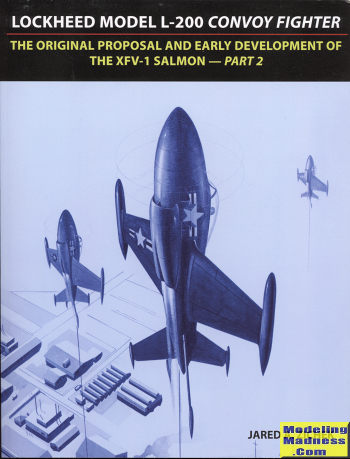 During the
last years of WWII and into the 1950s, the pace of aviation development was
staggering. Advances were coming so quickly that what was top of the line one
year, was nearing obsolescence just a few years later. It was also a time of
innovation where the military was not afraid to try something new and designers
were more than happy to stretch their abilities as well.
During the
last years of WWII and into the 1950s, the pace of aviation development was
staggering. Advances were coming so quickly that what was top of the line one
year, was nearing obsolescence just a few years later. It was also a time of
innovation where the military was not afraid to try something new and designers
were more than happy to stretch their abilities as well.
Such was the case of the Convoy Fighter. This was a plan to
allow ships in a convoy to carry a plane or two for self protection against
enemy bombers without the requirement for a large and expensive aircraft
carrier. The specifications called for a turboprop powered aircraft that could
land and take off vertically without the need for complex handling apparatus. It
should also be able to operate from a ship that was moving and so had to be able
to handle not only fore and aft movement but also side to side motion. These are
the motions that make most first time voyagers sea-sick.
Proposals were submitted by several companies and two were
chosen. These became the Convair XFY-1 and the Lockheed XFV-1. Both of these
planes flew, though only the Convair entry was able to take off and land
vertically. The main issue was the lack of power from available turboprop
engines and the difficulty of landing.
Had these proposals actually been able to overcome their
difficulties, it is conceivable that not only would these have made great close
infantry support aircraft, but would have been able to defend against the
perceived threats of the day. In some way, the modern Marine attack helicopter
is performing exactly the missions for which this aircraft was initially
conceived.
In this book, the author continues where he left off
regarding the Lockheed L-100 design in the first volume. As he states, this is
involved in the development of the aircraft and not in the construction or
flight testing, though some of that is mentioned in the end of the book.
The first part tackled in this edition is on the landing and
take off of the aircraft. Keep in mind that this was supposed to operate from
standard freighters or tankers with a landing/take-off pad on the back of the
ship. The aircraft also had to be able to be stable in 45 degrees of pitch and
roll. Frankly, I probably couldn't stand on a 45 degree angle, yet this aircraft
had to be able to stay on deck. The way the designers decided to tackle this was
to have the deck as steel grid. Once the plane landed tail first, spikes in the
end of each fin tip would open up once through the grid and hold the plane in
place. Tests were done with large scale models and it was successful in holding
the plane in place.
There also had to be a way to access the aircraft for
maintenance and a rather large and cumbersome looking gantry was developed to
allow the plane to be put into the horizontal for things like servicing and
engine changes. This was also to be able to hold the plane off the deck for an
alternate method of 'landing' and take off by having a mechanism into
which the spinner tip could be connected. Like a vertical dirigible attachment.
Then the actual design of the aircraft is covered. This plane
went through a considerable number of variations before one was eventually
chosen and all those are in the book. We also look at all the systems of the
finished design as well as other aircraft types (including a transport, recce
plane and light fighter) based on the technology of a VTOL aircraft.
Thanks to a very well kept archive many of the original
drawings, plans and artwork are included within. There are also some great
profiles of the various alternative aircraft that Lockheed was trying to get the
military to fund. Additionally, the development of horizontal take off landing
gear and the large scale models are covered, making this a fascinating look into
what could have been.
January 2018
Copyright ModelingMadness.com. All rights reserved.
My thanks to
www.retromechanix.com for providing the review
sample. You can get a hard copy
on www.Amazon.com or an electronic
version from the first link.
If you would like your product reviewed fairly and fairly quickly, please contact
the editor or see other details in the Note to
Contributors.
Back to the Main Page
Back to the Books Index
Page
 During the
last years of WWII and into the 1950s, the pace of aviation development was
staggering. Advances were coming so quickly that what was top of the line one
year, was nearing obsolescence just a few years later. It was also a time of
innovation where the military was not afraid to try something new and designers
were more than happy to stretch their abilities as well.
During the
last years of WWII and into the 1950s, the pace of aviation development was
staggering. Advances were coming so quickly that what was top of the line one
year, was nearing obsolescence just a few years later. It was also a time of
innovation where the military was not afraid to try something new and designers
were more than happy to stretch their abilities as well.